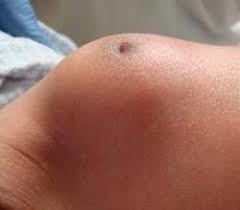A home health nurse is caring for a client who has unilateral mastitis and is experiencing discomfort in the affected breast. Which of the following Instructions should the nurse include?
Tell the client to apply hydrocortisone ointment to the affected area of the breast.
Recommend the client avoid wearing a nursing bra until symptoms resolve.
Suggest the client apply warm compresses to the affected breast.
Encourage the client to limit oral fluid intake to decrease milk production.
The Correct Answer is C
A) Incorrect- Hydrocortisone ointment is not typically recommended for treating mastitis, as it might not address the underlying infection.
B) Incorrect- Wearing a well-fitting, supportive nursing bra can actually help alleviate discomfort and is not typically contraindicated in cases of mastitis.
C) Correct - Applying warm compresses to the affected breast can help reduce pain and discomfort associated with mastitis. Warmth can improve blood flow and promote milk flow.
D) Incorrect- Encouraging the client to limit oral fluid intake to decrease milk production is not a recommended approach, as maintaining proper hydration is important, especially when dealing with infection.

Nursing Test Bank
Naxlex Comprehensive Predictor Exams
Related Questions
Correct Answer is A
Explanation
A) Correct - Group B streptococcus (GBS) screening is typically performed around 36 weeks of gestation to identify colonization. It helps determine whether antibiotic prophylaxis is necessary during labor to prevent transmission to the newborn.
B) Incorrect- Producing a clean catch urine specimen every 2 months is not a standard recommendation during pregnancy. Urine testing is common but does not usually occur this frequently.
C) Incorrect- Maternal serum alpha-fetoprotein screening is typically done around 15-20 weeks of gestation, not 6 weeks.
D) Incorrect- Screening for gestational diabetes typically occurs between 24 and 28 weeks of gestation, not 12 weeks.
Correct Answer is D
Explanation
A) Incorrect- Overlapping suture lines in a newborn are common and usually resolve as the baby grows. This finding is not typically concerning.
B) Incorrect- Acrocyanosis, bluish discoloration of the hands and feet, is common in newborns and is a normal physiological response to adjusting to the outside environment.
C) Incorrect- Hypotonia, or decreased muscle tone, can be present in newborns and may improve over time. It's important to monitor but may not necessarily require immediate reporting.
D) Correct - A blood glucose level of 40 mg/dL in a newborn is considered low and requires intervention. Hypoglycemia in a newborn can have serious consequences and should be promptly addressed.
Whether you are a student looking to ace your exams or a practicing nurse seeking to enhance your expertise , our nursing education contents will empower you with the confidence and competence to make a difference in the lives of patients and become a respected leader in the healthcare field.
Visit Naxlex, invest in your future and unlock endless possibilities with our unparalleled nursing education contents today
Report Wrong Answer on the Current Question
Do you disagree with the answer? If yes, what is your expected answer? Explain.
Kindly be descriptive with the issue you are facing.
